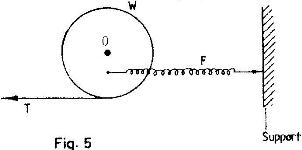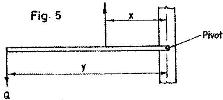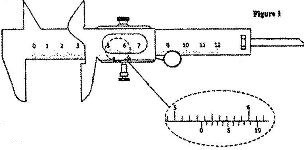F1 and F6
johnmulu answered the question on April 18, 2017 at 10:27
- Fig. 5 shows a wheel W pivoted at its centre, O and held stationary by string and a spring. The tension in the string is T and the force on the springs is F. Use this information to answer questions 2 and 3(Solved)
Fig. 5 shows a wheel W pivoted at its centre, O and held stationary by string and a spring. The tension in the string is T and the force on the springs is F. Use this information to answer questions a) and b)

a) State how the magnitude of T and F compare. Give reasons for your answer
b) State what would happen to the wheel if the string snapped
Date posted: April 18, 2017. Answers (1)
- The diagram in Fig. 5 shows a beam of negligible weight balanced by a constant forces P and Q.(Solved)
The diagram in Fig. 5 shows a beam of negligible weight balanced by a constant forces P and Q.
Derive the relations hip between x and y
hip between x and y
Date posted: April 18, 2017. Answers (1)
- Figure 1 shows parts of the main scale and vernier scale of a vernier calipers(Solved)
Figure 1 shows parts of the main scale and vernier scale of a vernier calipers

Record the reading indicated.
Date posted: April 18, 2017. Answers (1)
- Figure 1 shows a vernier calipers being used to measure the internal diameter of a tube(Solved)
Figure 1 shows a vernier calipers being used to measure the internal diameter of a tube

Record the diameter of the tube
Date posted: April 18, 2017. Answers (1)
- Figure 1 shows a metal cube of mass 1.75g placed between the jaws of a micrometer screw gauge.(Solved)
Figure 1 shows a metal cube of mass 1.75g placed between the jaws of a micrometer screw gauge.

The magnified portion of the scale is also shown. The reading on the guage when the jaws were fully closed without the cube was 0.012 cm. Use this information and the figure to answer questions a) and b)
a) What is the length of the cube?
b) Determine the density of the metal cube giving your answer correct to three significant figures
Date posted: April 18, 2017. Answers (1)
- Figure 3 shows part of an experimental set up for estimating the diameter of an oil molecule.(Solved)
Figure 3 shows part of an experimental set up for estimating the diameter of an oil molecule.

i) Describe how the oil patch is formed.
ii) Describe one method of determining the diameter of the oil drop
Date posted: April 18, 2017. Answers (1)
- Figure 1 shows a micrometer screw gauge being used to measure the diameter of a ball bearing. A magnified portion of the scale is shown(Solved)
Figure 1 shows a micrometer screw gauge being used to measure the diameter of a ball bearing. A magnified portion of the scale is shown

Date posted: April 18, 2017. Answers (1)
- Figure 1 shows a micrometer screw gauge being used to measure the diameter of a metal rod. The thimble scale has 50 divisions(Solved)
Figure 1 shows a micrometer screw gauge being used to measure the diameter of a metal rod. The thimble scale has 50 divisions

What is the reading shown?
Date posted: April 18, 2017. Answers (1)
- What is the reading on the vernier calipers shown in Figure 1?(Solved)
What is the reading on the vernier calipers shown in Figure 1?

Date posted: April 18, 2017. Answers (1)
- The micrometer screw gauge represented by Fig.1 has thimble scale of 50 divisions. What is the reading shown?(Solved)
The micrometer screw gauge represented by Fig.1 has thimble scale of 50 divisions. What is the reading shown?

Date posted: April 18, 2017. Answers (1)
- Figure 2 shows a soft iron bar AB placed in a coil near a freely suspended magnet.(Solved)
Figure 2 shows a soft iron bar AB placed in a coil near a freely suspended magnet.

Explain the observation made when the switch is closed.
Date posted: April 18, 2017. Answers (1)
- Figure 2 shows a horse – shoe magnet whose poles are labeled and two other magnets near it. Iron nails are attracted to the lower ends of the magnets as shown.(Solved)
Figure 2 shows a horse – shoe magnet whose poles are labeled and two other magnets near it. Iron nails are attracted to the lower ends of the magnets as shown.

Identify the poles marked X and Y
Date posted: April 18, 2017. Answers (1)
- In the set up in Figure 17 the metal rod is made up of steel and iron pieces joined end to end. You are provided with two iron nails.(Solved)
In the set up in Figure 17 the metal rod is made up of steel and iron pieces joined end to end. You are provided with two iron nails.

Explain how you would use two nails provided to determine which side is iron
Date posted: April 18, 2017. Answers (1)
- Figure 7 shows how magnets are stored in pairs with keepers at the ends(Solved)
Figure 7 shows how magnets are stored in pairs with keepers at the ends. Explain how this method of storing helps in retaining magnetic longer

Date posted: April 18, 2017. Answers (1)
- In an experiment to magnetize two substances p and Q using electric currents, two curves (graphs) were obtained as shown in fig. 1(Solved)
In an experiment to magnetize two substances p and Q using electric currents, two curves (graphs) were obtained as shown in fig. 1

Using this information in Fig. 1 explain the difference between the substances P and Q with reference to the domain theory
Date posted: April 18, 2017. Answers (1)
- Figure 4 shows the cross-section of a dry cell. Use the information on the figure to answer question a) and b)(Solved)
Figure 4 shows the cross-section of a dry cell. Use the information on the figure to answer question a) and b)

a) Name the parts labeled A and B
b) State the use of manganese (IV) oxide in the cell.
Date posted: April 18, 2017. Answers (1)
- Figure 12, shows an electrical circuit including three switches, S1, S2, S3 and three identical lamps L1, L2, L3. A constant potential difference is applied across X and Y.(Solved)
Figure 12, shows an electrical circuit including three switches, S1, S2, S3 and three identical lamps L1, L2, L3. A constant potential difference is applied across X and Y.

i) Other than L1, state the lamp that will light when S1 and S2 are closed.
ii) How does the brightness in L1 in (i) above compare with its brightness when all the switches are closed?
iii) Explain the observation in (ii) above
Date posted: April 18, 2017. Answers (1)
- Figure 7 shows the features of a dry cell (Leclanche’s). Use the information in the figure to answer the questions a and b(Solved)
Figure 7 shows the features of a dry cell (Leclanche’s). Use the information in the figure to answer the questions a and b

a) State the polarities of the parts labeled A and B.
b) Name the chemical substance in the parts labeled C and D
Date posted: April 18, 2017. Answers (1)
- Figure 10 shows two circuits in which identical dry cells and identical bulbs are used. Use the information in the figure to answer questions 9 and 10.(Solved)
Figure 10 shows two circuits in which identical dry cells and identical bulbs are used. Use the information in the figure to answer questions a) and b)

a) Explain why the bulb in Figure 10 (b) will be brighter than each of the bulbs in Figure 10 (a).
b) Give the reason why the cells in Figure 10 (b) can be used for a longer period than the cells in Figure 10 (a).
Date posted: April 18, 2017. Answers (1)
- Figure 10 shows two circuits in which identical dry cells and identical bulbs are used. Use the information in the figure to answer questions a) and b)(Solved)
Figure 10 shows two circuits in which identical dry cells and identical bulbs are used. Use the information in the figure to answer questions a and b

a) Explain why the bulb in figure 10 (b) will be brighter than each of the bulbs in figure 10 (a).
b) Give the reason why the cells in figure 10 (b) can be used for a longer period than the cells in Figure (10a)
Date posted: April 17, 2017. Answers (1)